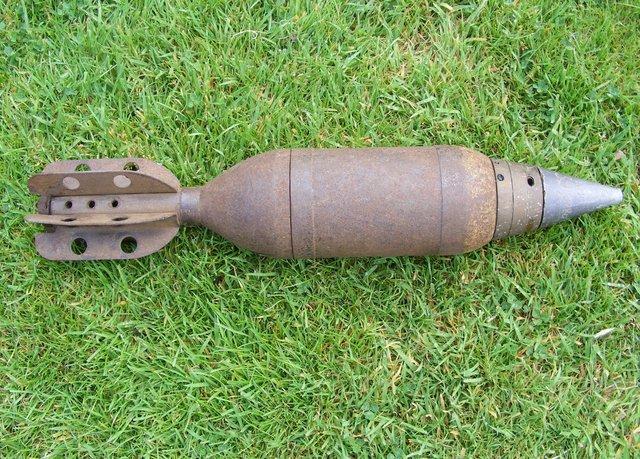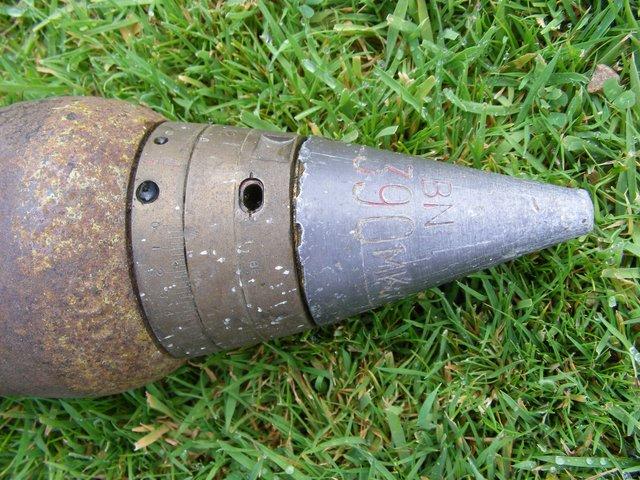-
Cinders, it's only anecdotal from a relatively small number of No36's I've seen or owned over the years, but the filler plugs (for the main bursting charge, not the base plugs) are usually brass (or possibly on occasions steel) on WW1 examples, but are often made of what looks to be either mazak or aluminium on WW2 production.
or aluminium on WW2 production.
-
Thank You to Roger Payne For This Useful Post:
-
08-19-2015 12:54 PM
# ADS
Friends and Sponsors

-
Legacy Member

Sorry but back ot teh sight. What identified this as a trials sight? is it the graduations or scale numbering?
-
-
The bottom is different to the standard run of production as it has a slightly different method of pivoting. The Trials examples are also EFD marked. Range grads are the same as usual, but early sights have a 4 click adjusting screw & later are 6 click.
-
The Following 3 Members Say Thank You to Roger Payne For This Useful Post:
-

Originally Posted by
Robert303

The practice Mills Bomb I got into trouble with when I took it to school was light grey. The trouble was 'Nothing' compared to what it would be if done today!
Hmmmm, I took in all sorts when at school, stuff I knew then was safe, but do remember a head teacher rambling on about stuff found on Moors and Hills etc (I was in Cumbria at the Last years of Secondary) in assembly and how we should report it and not bring it home or bring it to school.... It turned out one lad had found a 2" Mortar ( Smoke) not live but it it did cause a panic when some bird grassed him up.... I did tell him when we unearthed it with my metal detector don't take it to school......
I was taking all kinds in at the time, bayonets, inert grenades, replica 1911 ... the list is endless, today I wouldn't even get near the school gate...... probably wouldn't make it on the bus, maybe at the time thats why I never got any where with Christine T**** ....
-
The Following 2 Members Say Thank You to bigduke6 For This Useful Post:
-
-
-
Legacy Member

80mm Mortar Round


A while ago, about 50 years, I was with my Dad as we crossed Salisbury Plain, off on holiday. We stopped in a lay-by on the A303 for a break and I spotted the above lying in the grass. My Dad, ex RA (on mortars in WW2) reckoned it was safe enough - we could see that it was empty, but we took it to the Royal Marines at Lympstone who confirmed that it was a smoke round, and let us keep it. I bet they wouldn't do that now!
I don't know anything much about it, so if someone has the knowledge, I'd be interested to know more about it.
Charlie
Last edited by Charlie303; 08-20-2015 at 09:02 AM.
-
Thank You to Charlie303 For This Useful Post:
-
Advisory Panel



Originally Posted by
Charlie303

80mm Mortar Round
It would be an 81m or 3" mortar...with a time fuze on it. How did your dad know it was safe in the first place? Was it in two parts then? The tail fins separate? Don't just tell me again it's because he was a mortarman, I'm also a mortarman...
-
-
Legacy Member

Empty Mortar Round
Hi Jim,
Yes, it was in two halves, tail fins separate and he could see that it was empty.
Do the numbers mean anything to you? BN 390 Mk 5. The coloured band (green? Yellow?) does it signify anything?
Thanks,
Charlie
Last edited by Charlie303; 08-20-2015 at 11:25 AM.
-
-
Advisory Panel


Here's a site that deals with specifics. We just set them and had a working knowledge of their operations... British Fuzes - Ammunition Pages
Yes, colors are use to identify ammo. You'll find markings there too.
-
Thank You to browningautorifle For This Useful Post:
-
Legacy Member

-
or aluminium on WW2 production.
















 PM
PM







 of us legged it as fast as we could leaving Brian to bring up the rear. He hid that bloody thing in a cistern then brought it back to Perth hidden in his kit bag.
of us legged it as fast as we could leaving Brian to bring up the rear. He hid that bloody thing in a cistern then brought it back to Perth hidden in his kit bag.



